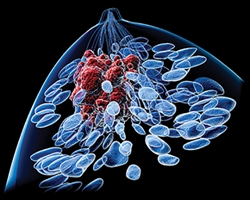A piece of noncoding DNA helps prevents cells from turning cancerous, and does so via two mechanisms. The noncoding DNA, which is called GNG12-ASI, acts both directly by regulating the transcription of a cell-replication gene, and also indirectly by producing noncoding RNA that interferes with a cell-migration signaling mechanism.
Direct and indirect effects of this sort are ordinarily hard to disentangle experimentally, but they were recognized as being distinct and independent by researchers at the Universities of Bath and Cambridge. These researchers, led by Adele Murrel, Ph.D., reader in regenerative medicine at University of Bath, made use of a technique called RNA interference.
In a paper (“Transcriptional silencing of long noncoding RNA GNG12-AS1 uncouples its transcriptional and product-related functions”) that appeared February 2 in Nature Communications, the researchers explained that they used multiple small interfering RNAs (siRNAs) to silence GNG12-AS1, which is a long noncoding RNA (lncRNA). GNG12-AS1 is transcribed in an antisense orientation to a neighboring gene, the tumor-suppressor DIRAS3, which is downregulated in 70% of breast and ovarian cancer.
“While most siRNAs silence GNG12-AS1 post-transcriptionally, siRNA complementary to exon 1 of GNG12-AS1 suppresses its transcription by recruiting Argonaute 2 and inhibiting RNA polymerase II binding,” wrote the authors. “Transcriptional, but not post-transcriptional, silencing of GNG12-AS1 causes concomitant upregulation of DIRAS3, indicating a function in transcriptional interference.”
The authors noted that the transcriptional effect, the change in DIRAS3 expression, sufficed to impair cell cycle progression. In addition, the post-transcriptional effect, the reduction in GNG12-AS1 transcripts, altered MET signaling, effectively suppressing a gene network that prepares cells to change their shape and participate in metastasis.
Importantly, the changes in signaling and metastatic behavior associated with the post-transcriptional effect were independent of the changes associated with transcriptional interference. The latter changes affected both migratory behavior and the cell cycle.
“The cells in our body occur in numbers that are balanced by the level at which the new cells replace the old cells that die. Sometimes the switches that control this growth get stuck in the ‘on’ position, which can lead to cancer,” explained Dr. Murrell. “As the tumor grows and the cancer cells get crowded, they start to break away from the tumor, change shape, and are able to burrow through tissues to the bloodstream where they migrate to other parts of the body, which is how the cancer spreads. This process is called metastasis and requires a whole network of genes to regulate the transformation of cell shape and mobilization.”
“In our study, we’ve identified that GNG12-AS1, a strand of noncoding RNA, prevents the growth switch getting stuck and suppresses metastasis,” Dr. Murrell continued. “The specific genomic region where this noncoding RNA is located often gets damaged in breast cancer patients—this control is removed and the cancer cells spread.”
“Research like this is helping is to unpick the precise details about how [noncoding genome] regions work,” added Kat Arney, Ph.D., science communication manager at Cancer Research UK. “[It sheds] light on their potential role in the development of cancer and pointing towards new approaches for tackling the disease.”
“Altogether,” concluded the authors of the Nature Communications paper, “our results demonstrate that an siRNA-based strategy can be employed to successfully separate functions that are due to lncRNA transcription from those of the transcript.”







